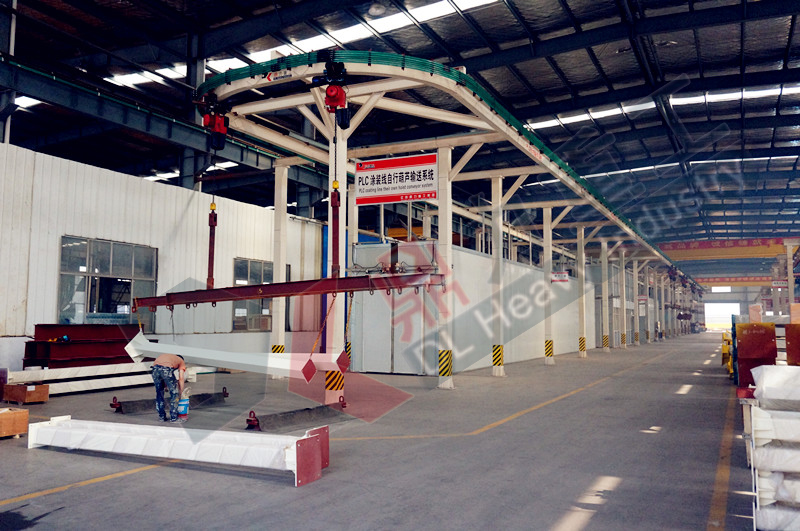 Products
Products Features
Features



In the painting process, the mechanized transportation system has always been the main production artery of the painting workshop. However, due to working under extremely harsh environmental conditions, it needs to withstand continuous erosion by acids, alkalis, and organic solvents, and must operate continuously for a long time in high temperature and humidity environments. Therefore, the selection of this type of conveying equipment must meet the conditions of ruggedness and durability, and a high degree of automation must also be achieved.
The self-propelled chain hoist conveying system is a mechanized conveying system widely used in the industry for coating conveying equipment. It is widely welcomed by automobile manufacturers due to its advantages such as flat conveying, vertical lifting, swinging of lifting tools, and storage.
 Specification Configuration
Specification Configuration


In the painting process, the mechanized transportation system has always been the main production artery of the painting workshop. However, due to working under extremely harsh environmental conditions, it needs to withstand continuous erosion by acids, alkalis, and organic solvents, and must operate continuously for a long time in high temperature and humidity environments. Therefore, the selection of this type of conveying equipment must meet the conditions of ruggedness and durability, and a high degree of automation must also be achieved.
The self-propelled chain hoist conveying system is a mechanized conveying system widely used in the industry for coating conveying equipment. It is widely welcomed by automobile manufacturers due to its advantages such as flat conveying, vertical lifting, swinging of lifting tools, and storage.
1、 Introduction to the self-propelled chain hoist conveying system
1. The operation of a self-propelled car is carried out on a track for hoisting aluminum alloy or I-beam under a steel structure in the air, or on a track installed in a pit, and power supply lines (sliding contact lines or special cables) are arranged on the inner side of the track. There are different numbers of cars on the track (which can be increased or decreased according to process requirements), and the self-propelled car in the air is composed of walking wheels, lifting devices, hanging materials, lifting tools, and the electric control system of the car, The ground mounted self-propelled vehicle is composed of a walking wheel, a lifting device, a pallet for carrying materials, and an electric control system for the vehicle. The vehicle is equipped with a power receiving device (collector or non-contact power receiving ring) that slides (or non-contact) with the power supply line (sliding contact line or special cable) to achieve the transmission of power supply and control signals.
2. The electrical control system includes a central console, LCD display, control cabinet, operation console (station), wiring, etc. According to different process action requirements and complexity, different control methods and modes can be selected for different usage scenarios.
a. Control method
Automatic control: automatic completion of process actions
Semi automatic control: Some process actions are manually completed, while others are automatically completed
Manual control: Process actions are completed manually
b. Control mode
Centralized control (using segmented voltage segmented control):
The PLC and components are centralized in the ground central control room. Equipped with a central console, control cabinet, analog display screen, etc., it can directly control and monitor the production site. Each workstation can operate at a high position, allowing for easy manual adjustment and troubleshooting without affecting the operation of the entire machine.
Features: No components are installed on the auxiliary beam and load truck, overcoming the erosion of corrosive gases on components and avoiding the impact of load truck vibration on components. The system has high reliability, convenient maintenance, and centralized management.
Applicable occasions: harsh production environments such as paint pre-treatment.
Variable frequency speed control:
Set up variable frequency speed regulation function in centralized control and distributed control systems.
Features: Equipped with a frequency conversion speed control device, the loading vehicle starts and stops more smoothly, and can be accurately positioned. The return time of the unloaded vehicle is short, and the equipment usage efficiency is improved.
Applicable occasions: occasions with high positioning accuracy requirements. Some workstations have special running times (such as shot blasting).
c. Introduction to System Functions
(a) Interlocking and interlocking functions
When there is a load truck in the current station, the load truck in the next station cannot move forward; When the load carrier chain hoist is not raised in place, the load carrier cannot run; When the load truck runs to the previous station of the turnout or lifting section, if the turnout or lifting section does not close as required, the load truck cannot continue to run.
(b) Display function
The LCD display screen can display the position and action status of on-site load carriers, chain hoists, turnouts, lifting sections, etc.
Dynamic simulation display (PLC and industrial personal computer networking) can conduct Dynamic simulation display of field operation status and print various reports.
(c) Fault diagnosis and alarm functions
The electronic control system has comprehensive fault diagnosis and alarm functions, such as diagnosis and alarm of motor phase loss and overload; Vehicle, hoist, road
 Success Cases
Success Cases